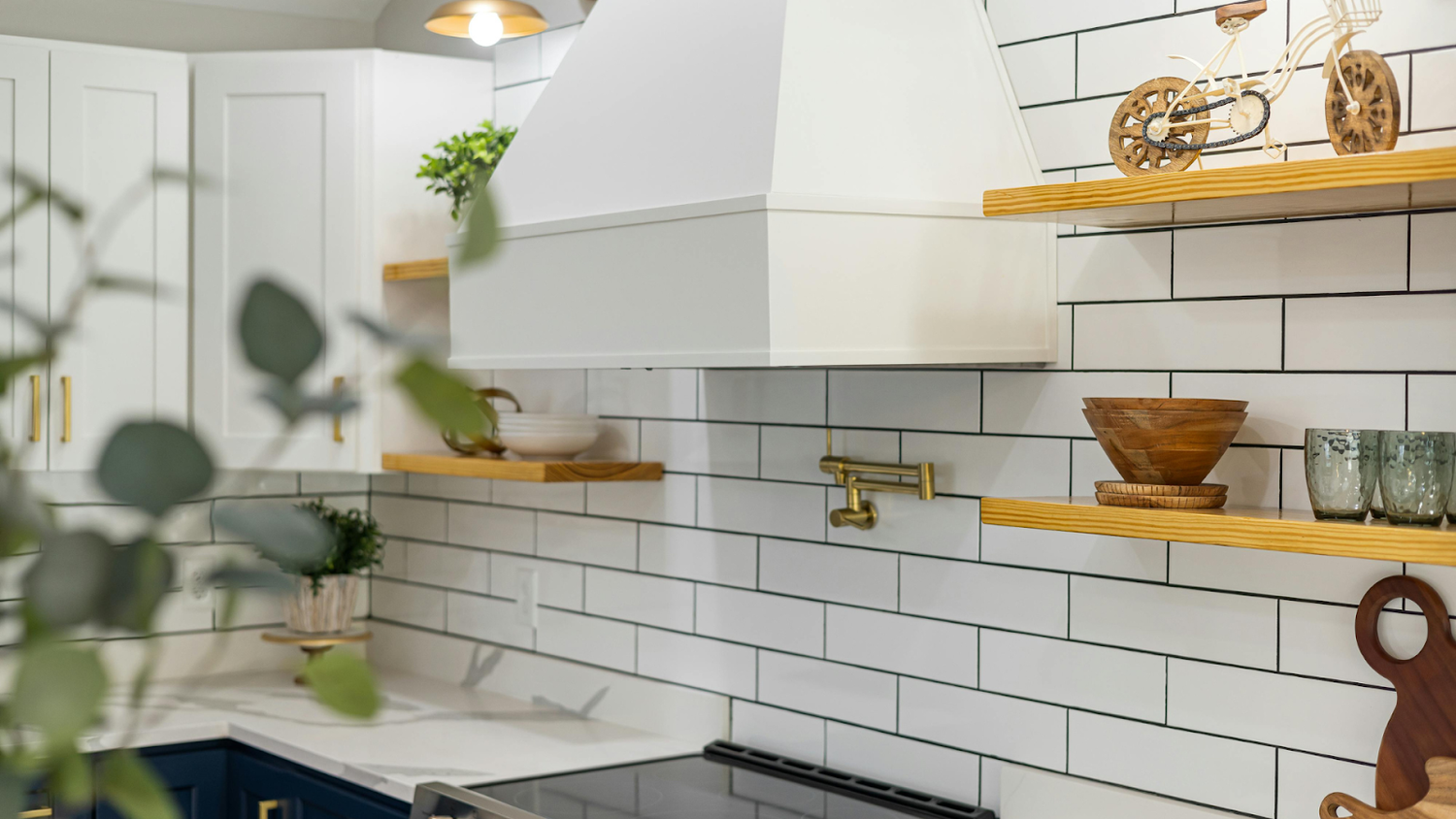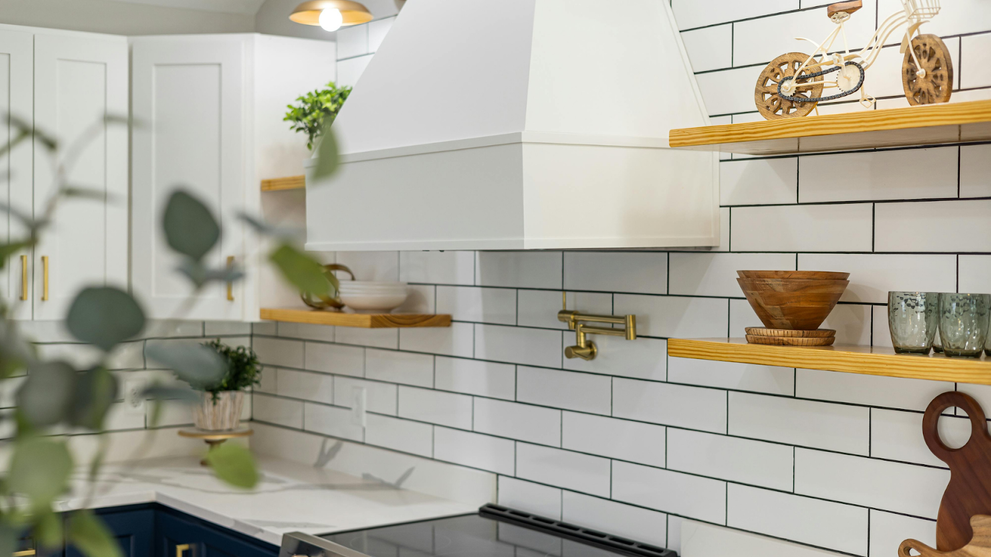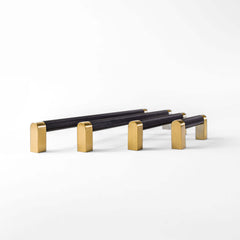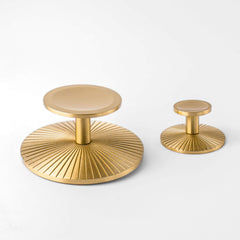Key Takeaways:
- How Lacquered And Unlacquered Brass Shape A Space: Each finish brings its own design language. Lacquered brass delivers consistent shine and structure, while unlacquered brass evolves, adding warmth and organic depth to interiors.
- How To Care For Brass Finishes Without Losing Their Charm: Lacquered brass thrives with gentle cleaning and minimal upkeep, while unlacquered brass invites more hands-on care, or a patient eye for natural patina.
- Pros And Cons Of Unlacquered Vs Lacquered Brass: Choosing between lacquered brass and unlacquered brass depends on your preference for permanence or transformation, and how much personality you want your hardware to bring into your space.
In every thoughtfully designed space, small details carry surprising weight—the gleam of a cabinet pull, the softened edge of a handle. These are the quiet touches that help a house feel personal, grounded, and lived in. At Inspire Hardware, we believe hardware completes a room’s story. Every knob and pull invites a decision that shapes how your space looks, feels, and evolves over time.
Among those choices, few are as quietly defining as selecting between lacquered brass and unlacquered brass. This subtle yet meaningful fork in the road can influence your home’s aesthetic and day-to-day experience. As you compare the two finishes, we’ll explore the textures, care routines, and visual transformations that distinguish them.
How Lacquered and Unlacquered Brass Shape a Space
Your chosen finish will impact the lifespan of your hardware and influence the entire mood of the room. From color and texture to aging patterns and design versatility, lacquered brass and unlacquered brass each bring their own character to the table. Beyond technicality, both choices reflect different styles, preferences, and interior visions.
Lacquered Brass: Bright, Polished, and Low Maintenance
Lacquered brass offers a clean, radiant finish that stays remarkably consistent over time. A transparent protective coating is applied to seal the surface, locking in the luminous glow of solid brass. This finish resists fingerprints and oxidation, maintaining a sleek profile with only occasional dusting.
Depending on the method used, lacquered brass can lean glossy or develop a soft satin sheen. While both finishes lend themselves beautifully to modern spaces that favor polish and precision, lacquered brass adds a refined warmth to marble-accented kitchens. Likewise, lacquered brass also pairs well with moody, monochromatic bathrooms where contrast matters but texture must stay crisp.
Designers working with high-touch environments often prefer lacquered hardware for its ability to hold its look across time and use. For a closer look at how different finishes behave, our guide to lacquer finishes dives deeper into care, curing, and how to match finishes with your design goals.
Unlacquered Brass: Evolving Color and Organic Texture
Unlacquered brass arrives bright but begins to change almost immediately. Without a protective seal, this finish invites natural oxidation. Over time, the golden tone deepens into amber, bronze, or even a rich tobacco brown depending on use, location, and light exposure. What starts as radiant becomes weathered and warm.
Each touch leaves behind subtle marks that gather into a textured, lived-in feel. This is the brass of old-world kitchens, European-style butler’s pantries, and heritage-inspired remodels where imperfection adds charm. The organic aging process resonates with interior styles that embrace softness and soul. Designers can pair unlacquered hardware with natural stone, unlacquered copper, or reclaimed wood for a curated and collected look.
Unlacquered brass also aligns with minimalist kitchens that blend vintage touches with modern forms. Explore how it contributes to understated beauty in our minimalist kitchen unlacquered brass feature. However, homeowners and trade professionals drawn to the lacquered brass vs unlacquered brass debate, this finish is typically the more expressive option.
How Brass Finishes Age Over Time and Use
The evolution of brass doesn’t happen overnight. Shaped by hands, light, moisture, and air, elements can gradually leave their mark on both lacquered and unlacquered finishes. From subtle shifts in tone to noticeable changes in texture, each path tells a different story. Let’s go over how each type ages.
Lacquered Brass: Resilient Shine with Subtle Wear
Lacquered brass is designed to hold its glow. A clear, protective coating shields the surface from oxygen and oils, making it less reactive to daily use. The finish resists fingerprints and tarnish, which helps preserve the original shine in high-traffic zones like kitchens, mudrooms, and busy bathrooms.
However, even well-sealed hardware can show signs of wear over time, particularly at touch points. In steamy environments or on frequently used cabinet fronts, the lacquer may begin to thin or develop small cracks near edges and corners. These areas can invite a soft, uneven patina to emerge where the protective barrier gives way.
In most cases, the overall finish remains intact, maintaining its polished feel for years. However, repairs can involve a full re-lacquering rather than a quick buff if restoration becomes necessary. For those who value long-term consistency with minimal upkeep, lacquered hardware offers a polished, resilient presence in the home.
Curious about how this type of finish interacts with light and surfaces? Our guide to lacquer finishes explores the technical process behind these protective layers and what makes them so enduring.
Unlacquered Brass: A Patina That Tells a Story
Unlacquered brass reacts freely to its environment. From the moment it's installed, the surface begins to evolve by gradually shifting in both tone and texture. Like with lacquered brass, frequent touchpoints may darken more quickly, while untouched corners hold onto their early warmth a little longer. Together, these changes form a distinctive patina that feels rich, soulful, and personal.
In a kitchen, this means drawer pulls near the stove may turn a deep bronze within months, while hardware on upper cabinets retains a lighter, golden hue. In bathrooms, natural humidity speeds the aging process, encouraging deeper coloration and matte textures. The effect is layered and lived-in—perfect for interiors that embrace softness, imperfection, and authenticity.
Do note that no two pieces age the same, and that uniqueness is part of the appeal for designers and homeowners who gravitate toward vintage, transitional, or collected styles. Touch by touch, these surfaces begin to feel like they belong—to the home, the people, and the stories being made inside.
To see how this finish interacts with natural materials and quiet luxury design, explore our minimalist kitchen unlacquered brass feature. The subtle aging pairs beautifully with soft woods, textured tile, and warm white paint palettes.
How to Care for Brass Finishes Without Losing Their Character
Routine maintenance can help your brass hardware retain its look, tone, and texture—whether you want to preserve a polished glow or encourage a gradual, natural patina. While care requirements for lacquered brass vs unlacquered brass differ, both finishes reward a thoughtful approach and a gentle hand.
Cleaning Lacquered Brass: Keep It Polished, Keep It Protected
Lacquered brass thrives with minimal maintenance. Its clear coating acts as a barrier between the metal and the world around it, blocking oxidation and helping the surface stay bright with little effort. In most cases, a soft microfiber cloth dampened with warm water is all you need. From there, wipe down gently, then dry with a clean cloth to avoid pesky water spots.
Avoid abrasive tools, cleaning sprays, or metal polishes, as these can damage the lacquer layer, creating dull patches or fine scratches. For stubborn smudges, a drop of mild dish soap diluted in water can help.
Lacquered finishes are well-suited for kitchens, bathrooms, and utility spaces where time-saving upkeep is a priority. Unlike unlacquered brass, the goal is to preserve the finish, not alter it, so gentle care is always best. For deeper insights into how the finish is formed and how to preserve it over time, explore our guide to lacquer finishes.
Caring for Unlacquered Brass: Shine or Patina, You Get to Decide
Unlacquered brass invites a more personal touch. Without a protective coating, the surface reacts to your hands, your environment, and even the air itself. This openness means the finish will darken and deepen over time, but you have control over how that evolution takes place.
To maintain a brighter look, clean unlacquered hardware with a non-abrasive brass cleaner or a homemade paste made from lemon juice and baking soda. Gently rub the surface, rinse well, and buff with a soft cloth. Avoid scrubbing too hard, as pressure can remove the subtle texture that gives the metal its warmth.
If you love the look of natural patina, cleaning becomes even simpler. A quick dusting or occasional dry buff is enough. Some designers even recommend lightly oiling unlacquered brass with a neutral product like mineral oil to encourage a richer, more even tone over time. For inspiration on how this finish pairs with layered materials and natural palettes, see our minimalist kitchen unlacquered brass showcase.
Pros and Cons of Unlacquered vs Lacquered Brass
The right brass finish depends on what you want your hardware to do for your space—visually, practically, and emotionally. The differences between lacquered brass and unlacquered brass are as much about style as they are about surface care. Below, we’ve broken down the key advantages and considerations for both finishes so you can select the one that fits your vision best.
Pros of Lacquered Brass: Consistent, Clean, and Easy to Maintain
This finish offers lasting beauty and practicality, maintaining a crisp, polished look that complements both contemporary and transitional interiors. Its low-maintenance nature—easily cleaned with just a soft cloth and warm water—keeps it looking fresh, while its resistance to fingerprints and oxidation ensures reliable performance in high-use spaces like kitchens and bathrooms. Designed for versatility, it pairs effortlessly with high-gloss cabinetry, stone counters, and minimalist hardware palettes that favor precision and clarity. Available in both gloss and satin variations, it not only enhances design flexibility but also protects the underlying brass, minimizing the need for refinishing or intensive upkeep.
Cons of Lacquered Brass: Limited Aging, Prone to Wear at Edges
This finish retains a consistent appearance over time, making it less suited for interiors where designers seek the rich patina associated with antique or biophilic styles. While its durability is generally strong, lacquer can thin or crack in high-touch areas such as drawer fronts or faucet bases, and repairing wear often requires re-coating the entire surface rather than simply buffing or spot cleaning. Its crisp, controlled look may also feel too structured for spaces that embrace softness, aging, and warmth.
Pros of Unlacquered Brass: Evolving Beauty with Deep Character
This finish naturally develops a unique patina influenced by touch, light, humidity, and air exposure, creating a rich, tactile surface that feels lived-in and storied over time. It works beautifully in farmhouse, European-style, vintage, and transitional spaces where subtle imperfections add depth and character, and each piece evolves differently, offering designers hardware that feels personal and dynamic. If desired, it can be polished back to its original tone for added visual flexibility, and it pairs seamlessly with natural materials like wood, linen, stone, and unlacquered copper.
Cons of Unlacquered Brass: More Maintenance, Less Predictability
This finish requires occasional polishing or oiling to manage the rate of patina development and can darken unevenly depending on placement and use, which may feel inconsistent in designs that rely on symmetry. It is also prone to spotting from water, fingerprints, and cooking oils, particularly in kitchen and bath environments, and may not suit every client’s comfort level with visible change and ongoing transformation over time.
Final Thoughts
Lacquered vs unlacquered brass is more than a materials debate, but rather, it’s a matter of soul, story, and the daily maintenance that shapes our lives. As you weigh the radiant shine and ease of lacquered brass against the deepening patina and tactile magic of unlacquered, the choice becomes personal.
At Inspire Hardware, we believe beauty is found as much in craftsmanship as in the experiences hardware quietly supports. These details, warm metal in your palm, the way light plays across a knob at dusk, are where design and daily life meet. Our curated collections span the enduring elegance of lacquered brass and the soulful richness of unlacquered, so you can find the perfect hardware for your sanctuary.
Read more:
- A Step-by-Step Guide to Painting Kitchen Cabinets Like a Pro
- The Different Types Of Cabinet Hinges And How They Work
- Modern Kitchen Ideas: 10 Cabinet Designs for a Fresh Look
Frequently Asked Questions: Lacquered vs Unlacquered Brass
Is lacquered brass more durable than unlacquered brass?
Lacquered brass is finished with a protective coating that shields the metal from air, moisture, and fingerprints. This makes it less reactive and helps maintain its original appearance over time. Unlacquered brass, by contrast, is exposed to the elements, which encourages a patina to form naturally. For a deeper dive into how finish types affect longevity and performance, explore our brass finishes explained guide.
Which is easier to clean: lacquered or unlacquered brass?
Lacquered brass is the easier of the two to clean. Its smooth, sealed surface repels dirt and smudges, usually, a soft, damp cloth is all you’ll need to keep things gleaming. Unlacquered brass requires a more mindful touch. Since it’s unprotected, harsh chemicals or scrubbing can damage the natural patina or alter its texture, so opt for mild soap and water and pat dry with care.
Does unlacquered brass require frequent maintenance?
Unlacquered brass is for those who fall in love with transformation. It needs attention if you want to maintain a certain stage of patina, or keep it bright and new. Left alone, it will react to its environment and tell its own story, deepening in color and character over time. Want it to stay polished?
Is either type more resistant to scratches?
Lacquered brass has a distinct advantage here. The lacquer acts as an armor against minor scratches and scuffs, making it suitable for high-traffic zones or cabinetry that gets daily action. Unlacquered brass, being exposed, can show scratches more easily, but for many, these subtle marks are part of its evolving appeal and soulful patina.
What is the cost difference between lacquered and unlacquered brass?
While costs can vary by artisan and specific finish, at Inspire Hardware, we strive for approachable luxury in both our lacquered and unlacquered brass pieces. Typically, lacquered brass may require additional finishing steps, which can reflect in the price, but the difference is often nominal. For product-specific pricing, browse our collection of solid brass cabinet knobs, where you’ll find both finishes represented.
Which style suits traditional interiors better?
Unlacquered brass is woven into the history of traditional design, favored for its living finish and ability to age gracefully. Lacquered brass also works in timeless spaces when paired with classic silhouettes like our Auburn brass pulls finishes. However, both can complement traditional interiors—it all depends on your preferred texture and finish behavior.
Can you achieve a patina on lacquered brass?
Not naturally. The very purpose of lacquer is to freeze time and shield the brass from the air and hands that create a patina. If you love the look of brass that darkens and shifts with time, unlacquered is the better choice. For more on how finishes behave across months and years, refer to our brass finishes explained resource.
What’s best for households with kids or pets?
Lacquered brass is your friend in busy spaces. Its sealed coating guards against little fingerprints, accidental spills, and mischievous paws, making it easier to live with and simpler to clean. While beautiful, unlacquered brass can show spots and change more rapidly with regular handling, which can be lovely if you like a well-worn look, but calls for a certain ease with imperfection.







